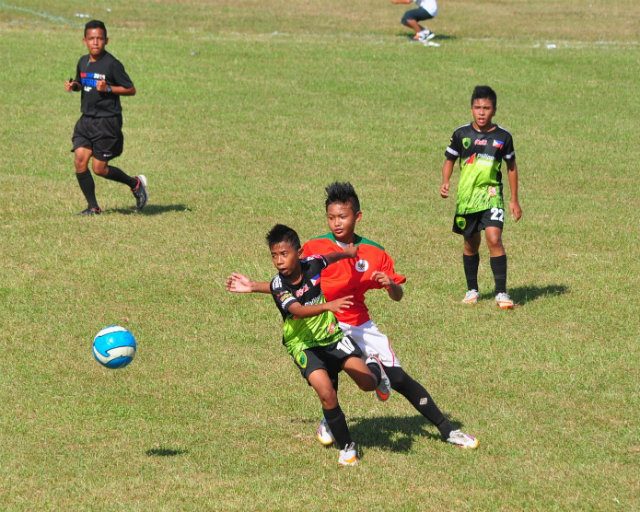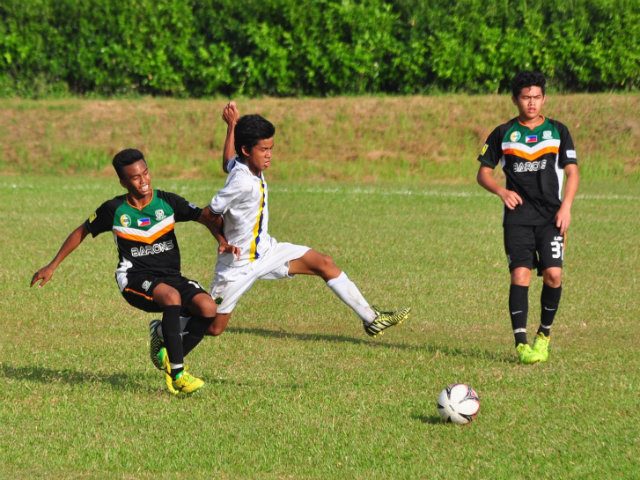SUMMARY
This is AI generated summarization, which may have errors. For context, always refer to the full article.

The Fields at Nuvali in Santa Rosa, Laguna are something akin to a footballing Disneyland in a nation badly in need of football venues. There are no less than 7 of them, tiered from front to back, surrounded by tall grass that routinely devour wayward footballs. And on a sweltering Saturday, the pitches are abuzz with activity.
Not only are there dozens of kids kicking around, but tents ring the fields, with teams loitering around as they wait for matches.
A total of 85 teams from all over the nation entered this year’s Pilipinas Cup, the fourth running of an event run by Manila Soccer Academy during the semestral break before All Saint’s Day. A quick check of the standings/tables board reveals that squads have made the trip to Nuvali from near and far.
Higala FC from Cagayan de Oro has entered 5 squads, for a total of 70 players. Don Bosco Cebu is here, as are teams from Virac, Catanduanes, and Naga. Tanauan, Batangas, has a team as does Nasugbu, which is run by an avuncular Caucasian who I am told is Swiss.
There are teams from Cavite as well, and plenty of sides from Metro Manila, including teams in the U17 girls division from Nomads and Poveda. FEU, UST, and Ateneo have entered their high school teams.
Unlike most 7-a-side football festivals, the 4-day long Pilipinas Cup is mostly 11-a-side with the offside rule. Only the youngest age groups below U13 have smaller-sided games.
“Some of the teams here, especially from the provinces, have a hard time with the offside rule,” explains Monty Roxas, who is involved with MSA and helps run the event with Troy Borja and Maxi Abad.
“They’re always offside,” continues Roxas, who runs MSA’s UFL second-division team, MSA Agila. Roxas is the brother of Randy Roxas, the vice-chairman of the Loyola Meralco Sparks.
The Pilipinas Cup matches are not full 90-minute games, of course. Each match is comprised of two 25-minute halves, so teams don’t get too overplayed even though there is a round-robin-stage that feeds into a Cup playoffs for the best teams and a Plate competition for those who finished lower in the group.
“There is no better tournament than the Pilipinas Cup,” gushes Ian Llego from Higala.
“This is the pinnacle of our year.”
The event is loved by many of the teams, even though most have to plane in for the games. No doubt a lack of true 11-a-side competition hampers teams from the provinces.
That isn’t the only hindrance to proper youth development in Philippine football. An enormous lack of qualified coaching is a big issue.
Cagayan De Oro Football Association president Percy Guarin told me there are more than two hundred licensed coaches in the Philippines, of which most are “C” license coaches, 48 are “B” license mentors, and just 12 are elite “A” license coaches. However these numbers may not be all that up to date since the PFF regularly conducts coaching courses at all levels, including the basic National Certificate Coaching Course that is below the “C” license. So there could be a few more at each level.
Guarin made a screen grab of a slide from a coaching course he took in Japan this year that listed the number of registered coaches in Japan. That country has about 25% more people than the Philippines, yet has 79,029 licensed coaches. The number of “A” license coaches in the land of the Rising Sun numbers more than 1,300, more than 6 times the number of our entire coaching stable.
So the reality on the ground is that there may be tons of young kids playing the beautiful game all over the country, but the vast majority do not have a knowledgeable and licensed coach to teach them proper technique and tactics. Plus there is a dearth of competitions, especially 11-a-side ones, to give them invaluable game experience.
It’s a shame, since it is a fallacy that the Philippines is not a footballing nation. A quick look at rosters from UAAP, NCAA, and UFL teams will reveal that football is indeed played all over the archipelago.
Iloilo and Negros may be the traditional hotbeds, but there are scores of players from Mindanao, especially Compostela Valley, Bukidnon, Davao, Gingoog, Cotabato, and even from the Zamboanga area.
Cebu has plenty of players in the UAAP, with many from Liloan and even a few from Bantayan island.
The Oriental side of Negros is also still a source for quality players.
Palawan also has players in the UAAP, as does Romblon, an underrated hotbed. Almost every team in the UAAP, plus San Beda, has players from Masbate.
Move on up to Luzon, and you will see Quezon province and the Bicol region represented in our leagues. Batangas has players as well, with the University of Batangas Brahmans capturing both the NCAA South title and the Ang Liga second-division crown.
There’s football in Tarlac and Pampanga too. Baguio has players in the NCAA, especially in Lyceum of the Philippines University.
Of course, Metro Manila has no shortage of teams, competitions and programs.
In my opinion, when it comes to sheer numbers of raw material, we MUST have more youth players than Singapore and perhaps even more than other less-populous ASEAN nations. But if there isn’t a structure to turn the raw material into world-class, professional football players, then we will continue to struggle at the youth level internationally. There was a stark reminder of this in the Pilipinas Cup in the form of the Timnas Pelajar Indonesia U13 national team.

Indonesia are currently suspended by FIFA, so they are unable to join international competitions at any level, both for clubs or national teams. Therefore they need events like this to keep their players sharp.
Roxas said the Indonesians found the Pilipinas Cup on the Internet and sent over their born 2002 squad to play. The Indonesian rifled through their group unruffled, then beat a very strong Makati Football Club-PLDT team in the semis 3-0 to set a date with I, Pag-asa FC from Iloilo.
Joebert and Linette Uygongco, a married couple from Iloilo, have brought I, Pagasa to the Pilipinas Cup a week before they take the side to the Singa Cup in Singapore, where they were champs last year. Their side is a selection from all over Iloilo, and they are actually a year younger than than their opponents because the Singa Cup age cutoff is a year younger.
The visitors toy with the brave I, Pagasa team on a smallish pitch. Their style is quick-passing with lots of speed on the flanks as well. The ball-control and off-the-ball movement is astounding. Only wasteful finishing denies the Indonesians a heavier scoreline as they run out 2-0 winners.
I, Pagasa try their best but their players betray a lack of composure in many instances, rushing ill-advised passes even when they have time on the ball. But no doubt, the game means terrific exposure for the kids as they head off to Singapore.
The Pilipinas Cup will have even more foreign teams next year, which should be a boon for youth football in the country. But if the Philippines wants to take the next step up in youth football, what is needed is a Pilipinas Cup in every region, every month of the year. Without massive investment, fan interest, and marketing savvy, that would be a very tall order for all of the stakeholders of Pinoy football. – Rappler.com
Learn more about the Pilipinas Cup at its Facebook page here.
Follow Bob on Twitter @PassionateFanPH.
Add a comment
How does this make you feel?
There are no comments yet. Add your comment to start the conversation.